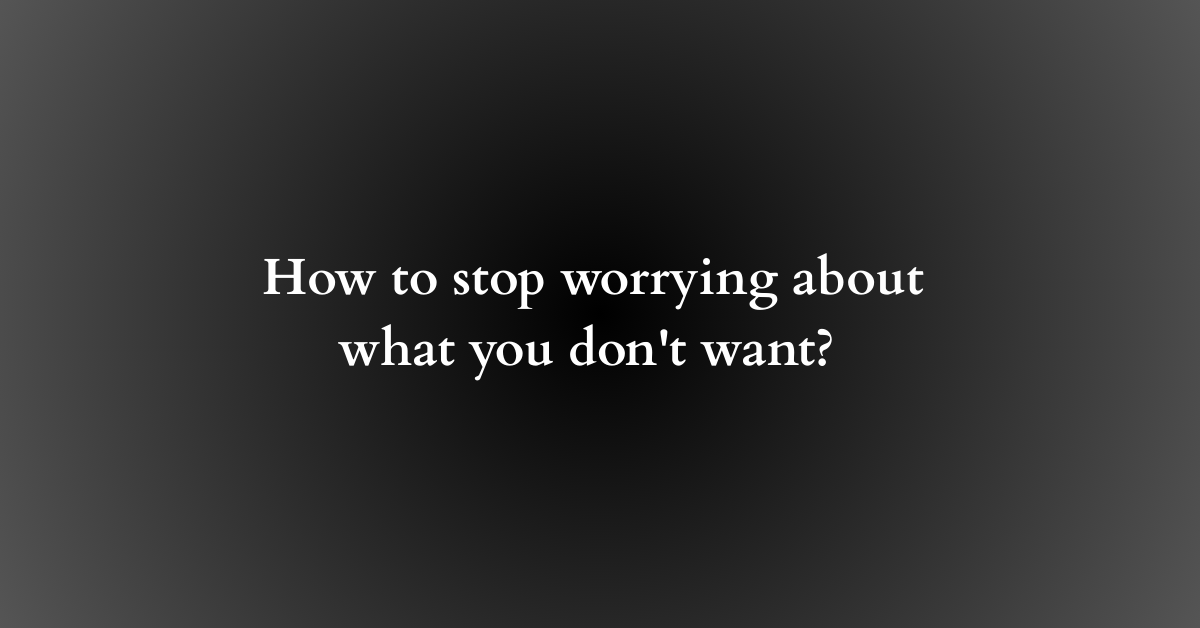How to stop worrying about what you don’t want?
Breaking the Cycle: How to Shift Your Focus and Stop Worrying About What You Don’t Want
Worry. It’s a ubiquitous human experience, a persistent hum in the background of our lives. We worry about our finances, our relationships, our health, the future, the past… the list seems endless. But often, this worry isn’t about actively seeking something we want. Instead, it’s about obsessing over what we don’t want – failure, rejection, illness, poverty, loneliness. This negative focus, while seemingly protective, is ultimately debilitating. It drains our energy, clouds our judgment, and ironically, can even contribute to the very outcomes we fear.
So, how do we break this cycle? How do we redirect our mental energy away from what we don’t want and towards what we do? This is a challenging but achievable goal, requiring conscious effort, practical strategies, and a fundamental shift in perspective.
Understanding the Roots of Negative Focus:
Before we dive into solutions, it’s crucial to understand why we get stuck in this negative feedback loop. Several factors contribute:
- Evolutionary Programming: Our brains are wired for survival. We’re naturally inclined to scan for potential threats and dangers, making negative information more salient than positive. This “negativity bias” helped our ancestors avoid predators and survive harsh conditions.
- Fear of the Unknown: Uncertainty breeds anxiety. We often worry about what we can’t control or predict, focusing on the worst-case scenarios as a way to feel prepared.
- Past Experiences: Negative experiences can create mental schemas or “scripts” that make us anticipate similar outcomes in the future. If you’ve been rejected in the past, you might be more prone to worrying about future rejection.
- Perfectionism and Control: The desire to control every aspect of our lives can lead to excessive worry about things going wrong. Perfectionists often focus on potential flaws and imperfections, fueling their anxiety.
- Cognitive Distortions: These are thought patterns that distort reality and amplify negative emotions. Examples include catastrophizing (imagining the worst possible outcome), overgeneralization (drawing sweeping conclusions from a single event), and personalizing (taking things personally that are not necessarily about you).
Practical Strategies for Shifting Your Focus:
Now that we have a better understanding of the underlying causes, let’s explore some actionable strategies for shifting your focus away from what you don’t want and towards what you do.
1. Cultivate Awareness and Acknowledge the Worry:
The first step is recognizing when you’re engaging in negative rumination. Become an observer of your own thoughts. Ask yourself: “Am I dwelling on something I don’t want to happen?” If the answer is yes, acknowledge the worry without judgment. Don’t try to suppress it or beat yourself up for feeling anxious. Simply recognize its presence.
2. Challenge Your Thoughts:
Once you’ve acknowledged the worry, challenge the underlying assumptions and beliefs. Ask yourself:
- Is this thought based on facts or feelings? Is there concrete evidence to support my fears, or am I just making assumptions?
- What’s the likelihood of this actually happening? Are my fears realistic, or am I exaggerating the potential consequences?
- What’s the worst-case scenario? If the worst does happen, how would I cope? What resources and support systems do I have available?
- Is there another way to look at this situation? Can I reframe the problem in a more positive or neutral light?
- What advice would I give to a friend who was in this situation? Often, we are more compassionate and rational when advising others.
By questioning your thoughts, you can begin to dismantle the negative thought patterns that fuel your worry.
3. Practice Gratitude:
Gratitude is a powerful antidote to negativity. When you focus on what you’re grateful for, it’s harder to dwell on what you lack or fear. Make a conscious effort to appreciate the positive aspects of your life, no matter how small. Keep a gratitude journal, express appreciation to others, or simply take a few moments each day to reflect on the things you’re thankful for.
4. Define Your Goals and Values:
What truly matters to you? What are your goals and aspirations? Clarifying your values and setting meaningful goals can provide a sense of purpose and direction, shifting your focus away from potential problems and towards achieving your desired outcomes. When you’re working towards something you care about, you’re less likely to be consumed by worry and anxiety.
5. Take Action:
Often, worry stems from a feeling of powerlessness. Taking action, even small steps, can restore a sense of control and reduce anxiety. If you’re worried about your finances, create a budget and start saving. If you’re worried about your health, schedule a doctor’s appointment and make healthy lifestyle choices. The act of taking action can break the cycle of rumination and empower you to create positive change.
6. Practice Mindfulness and Meditation:
Mindfulness is the practice of paying attention to the present moment without judgment. It involves observing your thoughts and feelings without getting caught up in them. Meditation is a technique for training your mind to focus on the present moment, which can help to reduce stress, anxiety, and negative thinking. Regular mindfulness and meditation practice can help you become more aware of your thoughts and feelings, allowing you to detach from negative rumination and cultivate a more peaceful state of mind.
7. Engage in Activities You Enjoy:
When you’re feeling overwhelmed by worry, it’s important to engage in activities that bring you joy and relaxation. This could be anything from reading a book to spending time in nature to listening to music to exercising. Engaging in enjoyable activities can help to distract you from negative thoughts and boost your mood.
8. Seek Professional Help:
If your worry is persistent, overwhelming, and interfering with your daily life, it’s important to seek professional help. A therapist or counselor can provide you with tools and techniques for managing your anxiety and developing healthier coping mechanisms. Cognitive Behavioral Therapy (CBT) is a particularly effective treatment for anxiety disorders, helping individuals identify and change negative thought patterns and behaviors.
9. Be Patient and Persistent:
Changing your thought patterns and overcoming worry is a process, not an event. It takes time, effort, and patience. Don’t get discouraged if you slip up or have setbacks. Just keep practicing the strategies outlined above, and you’ll gradually develop a more positive and resilient mindset.
The Power of Positive Visualization:
Finally, let’s touch on the power of positive visualization. Instead of imagining the worst-case scenario, actively visualize yourself succeeding and achieving your goals. Imagine the positive outcomes you desire, the feelings of accomplishment and joy. This practice can reprogram your subconscious mind, shifting your focus from what you don’t want to what you do.
Conclusion:
Worrying about what you don’t want is a natural human tendency, but it doesn’t have to control your life. By understanding the roots of negative focus and implementing the practical strategies outlined above, you can break the cycle of worry and cultivate a more positive, proactive, and fulfilling life. Remember to be patient with yourself, celebrate your progress, and never stop striving to create the life you desire. The power to shift your focus and transform your experience lies within you.







